2008-04-08 (Flight #2002) |
Flight Photo Album |
Aircraft Flight SummaryDate: 2008-04-08 |
Flight Track Map
Larger image (new window) Download KMZ/KML File (right click, save as) |
Satellite Image from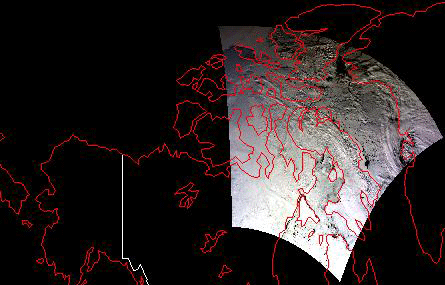
MODIS/Terra larger image (morning) (new window) MODIS/Aqua larger image (afternoon) (new window) |
Satellite Images from GOES-11 0800 - 1900 UTC |
CAR - (QuickLook)
Imagery from CAR Instrument
Click browse image thumbnail to load more detailed version (images open in a new window)
| Flight Direction | Flight Direction |
|
|
|

|

|
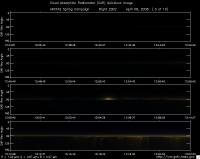
|
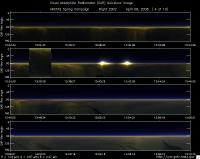
|

|

|

|
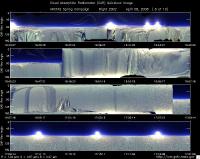
|
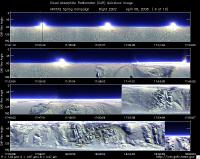
|

|
Flight Mission Details
Overview:
This was the 2nd flight out of Alaska. Pre-flight goals included intercomparison with the DC-8 on the way to Greenland and optional BRDF measurements over snow/ice or fly under CALIPSO track with DC-8 over Eureka, Greenland.
P-3B instrument payload:
AATS: Ames Airborne Tracking Sunphotometer (AATS) measured direct solar beam transmission at 14 wavelengths between 354 and 2139 nm in narrow channels with bandwidths between 2 and 5.6 nm for the wavelengths less than 1640 nm and 17.3 nm for the 2139 nm channel. No major issues reported.
AERO3X: measured aerosol extinction ( no scattering measurements on this flight) at 405 nm and 675 nm. NO2 mixing ratio. Issues with dirty mirror and air flow. Mirrors cleaned 3 times during the flight.
BBR: Broad Band Radiometer measured: Down- and Up-welling Solar (0.2-3.6 µm) and IR Irradiance (4.2-42 micron).No issues reported.
CAR - Cloud Absorption Radiometer measured angular distribution of scattered radiation and acquired imagery of cloud and snow/ice surface features enroute to Greenland. BRDF measurements over ice near Eureka, Greenland.
CCN Counter - Continuous-Flow Streamwise Thermal Gradient Cloud Condensation Nuclei (CCN) Counter (CFSTGC) - counted the fraction of aerosol particles that become droplets when exposed to a given water vapor supersaturation (RH > 100%). Worked well entire flight. One minor issue with OPC.
COBALT - Carbon monOxide By Attenuated Laser Transmission (COBALT), an autonomous instrument based on off-axis integrated cavity output spectroscopy took measurements of carbon monoxide. Reported a good flight. Minor current problems reported.
HiGEAR - Hawii Group for Environmental Aerosol Research (HiGEAR) suite of instruments measured size resolved aerosols. Sampled off of inlet entire flight. SP2 recorded good data. f(RH) reportedly high. AMS worked well.
PDS Project Data System (PDS) measured base meteorological and navigational measurements. No issues reported.
REVEAL - The Research Environment for Vehicle-Embedded Analysis on Linux (REVEAL) system is a prototype next-generation tool for aerospace vehicle sensor webs and the future Earth Observation System. Made good progress in testing the system.
SSFR -Solar Spectral Flux Radiometer measured spectrally resolved solar irradiance (380 nm to 2200 nm) over snow/ice and clouds. No issues reported.
Flight Path, Timing, and Measurements
Approximate time in UTC (Alaska time - 8 hours). Activities during CAR flight 2001 on April 8, 2008 out of Fairbanks International Airport, Alaska heading Thule, Greenland. Observations by CAR operator/PI, Charles Gatebe.
10:24 -- Engine on.
10:32 -- taxing. (timeout per WFF flight report is 10:30).
10:39 -- takeoff.
10:49 -- showers reported.
10:59 -- CAR power on. (its night time in Alaska, so CAR images are dark, but good for calibration. Instrument kept running to keep it warm.). Nav temp. -17 deg. C.
11:28 -- filter wheel channels not stable. Signal stays roughly -10 counts to -4. Need to check stability of the dark current.
12:13 -- UV signal increase. Sun is breaking through the horizon.
12:55 -- 2 layers of aerosol seen towards the horizon.
13:05 -- Circular orbit to help the CAR scan the sun on the horizon.
13:35 -- CAR scanning the surface from horizon to horizon perpendicular to the flight track.
13:37 -- CAR scanning in the starboard from zenith to nadir.
14:14 -- Descend to 2134 m msl.
14:35 -- Clouds reported. Broken ice surface.
14:39 -- Descending to lower level. leveling at 323 m. AOD ~0.08 (0.499 µm). RH~100%. Sulphate reported.
14:56 -- low level leg at 60 m msl.
15:35 -- const ratio between 0.380/0.340 µm, 0.470/340 µm.
16:27 -- P-3 contrail above and its shadow seen on the ice surface.
16:47 -- 152 m msl, flying over a valley. (airport seen).
17:13 -- BRDF measurements - circle #1. AOD ~0.09. Contrails in the forward direction;
17:24 -- Filter wheel at 1.6 µm.
17:25 -- CAR BRDF circle #5.
17:29 -- CAR BRDF circle #6. Mountain range towards the horizon. Roll and pitch inaccurate.
17:35 -- end of BRDF measurements.
18:41 -- CAR in park position.
18:44 -- CAR door closed and CAR power off.
19:08 -- landed in Thule,Greenland. (timein per WFF flight report is 19:05).
